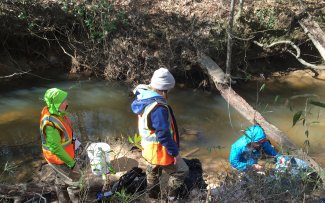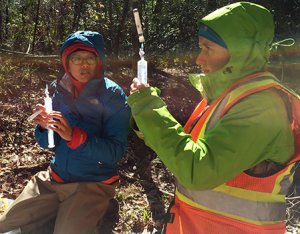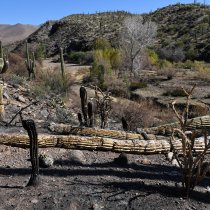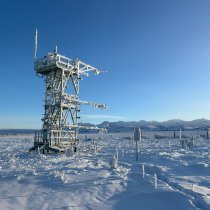Testing muddy waters: protocol performance in Alabama wetlands
April 30, 2015
By Stephen Craft
My colleague April Evans and I recently traveled to Mayfield Creek, the core aquatic NEON site for the Ozarks Complex (Domain 08). The site is gorgeous, embedded in dense forest wetlands about 20 miles southeast of Tuscaloosa, Alabama. The stream itself isn’t big, maybe 15-20 feet across and just a few feet deep, with a deep khaki hue because of its heavy sediment content. We were there to test a few of the Aquatic Observation System (AOS) field protocols that guide collection of reaeration, discharge and water chemistry data.

Temperature measurements at a NEON aquatic stream site
Acceptance testing field protocols
Field protocols are workflows that NEON field technicians follow while gathering samples and data in the field. They are drafted with input from the scientific community and are an important tool for standardizing data collection methods at NEON sites. We perform acceptance tests of protocols to ensure that protocols are understandable and executable in the field: we consider factors such as environmental impact, technician safety, efficacy across various environments, ease of implementation and quality of data produced. Ultimately, we’re there to see how well the protocols hold up during the transition to the real world from the un-muddy, climate-controlled confines of NEON headquarters in Boulder. Once the protocols pass acceptance testing, NEON makes them openly available to give scientists a better understanding of our data products and to enable them to use our collection methods in their own research.
Reaeration

Setting up to do the reaeration protocol at Mayfield Creek, AL (D08)
The rate at which a stream exhales oxygen varies depending on canopy cover, water depth and speed, slope or elevation change, and sediment content. To find out how a given stream reaerates, NEON technicians inject the stream with sulfur hexafluoride, a synthetic, non-reactive gas. This gas leaves the stream at about the same rate as oxygen, so by injecting it upstream and testing for its presence downstream over time, we can determine the rate at which it leaves the stream—also known as the reaeration rate.
This number feeds into the larger metabolism calculations that define how the stream interacts with its environment. All the components of this environment depend on each other: the outputs from one system act as the inputs for another. Only by understanding these inputs and outputs do we reach an understanding of the system as a whole.
Takeaways
Our performance testing in Alabama was successful in that the protocols stood up to Mayfield’s challenging setting. But the real success comes in finding the problems, because it provides us opportunities to improve the protocols. We find ways to minimize our impact on the environment and make the protocols more efficient. Each of these is a small step toward strengthening the quality of data NEON collects - and in turn, improving scientific research that uses NEON data.
Find the reaeration protocol and many others on the NEON Data portal.


